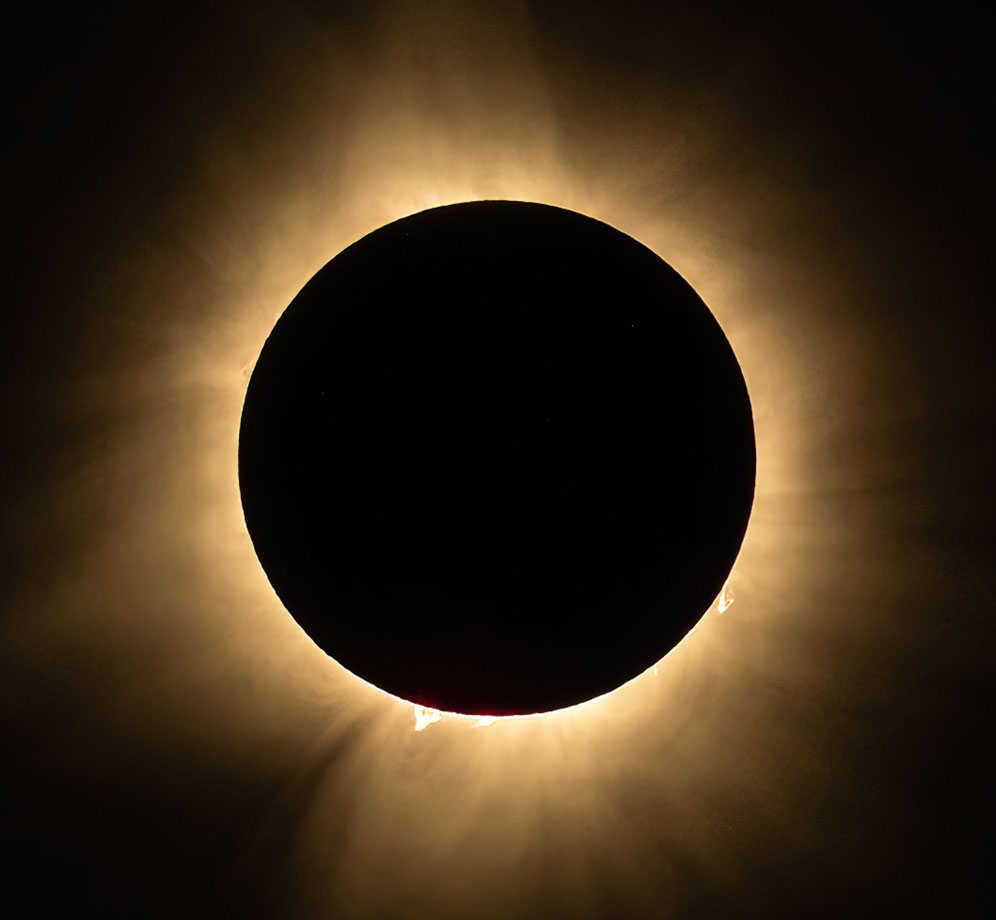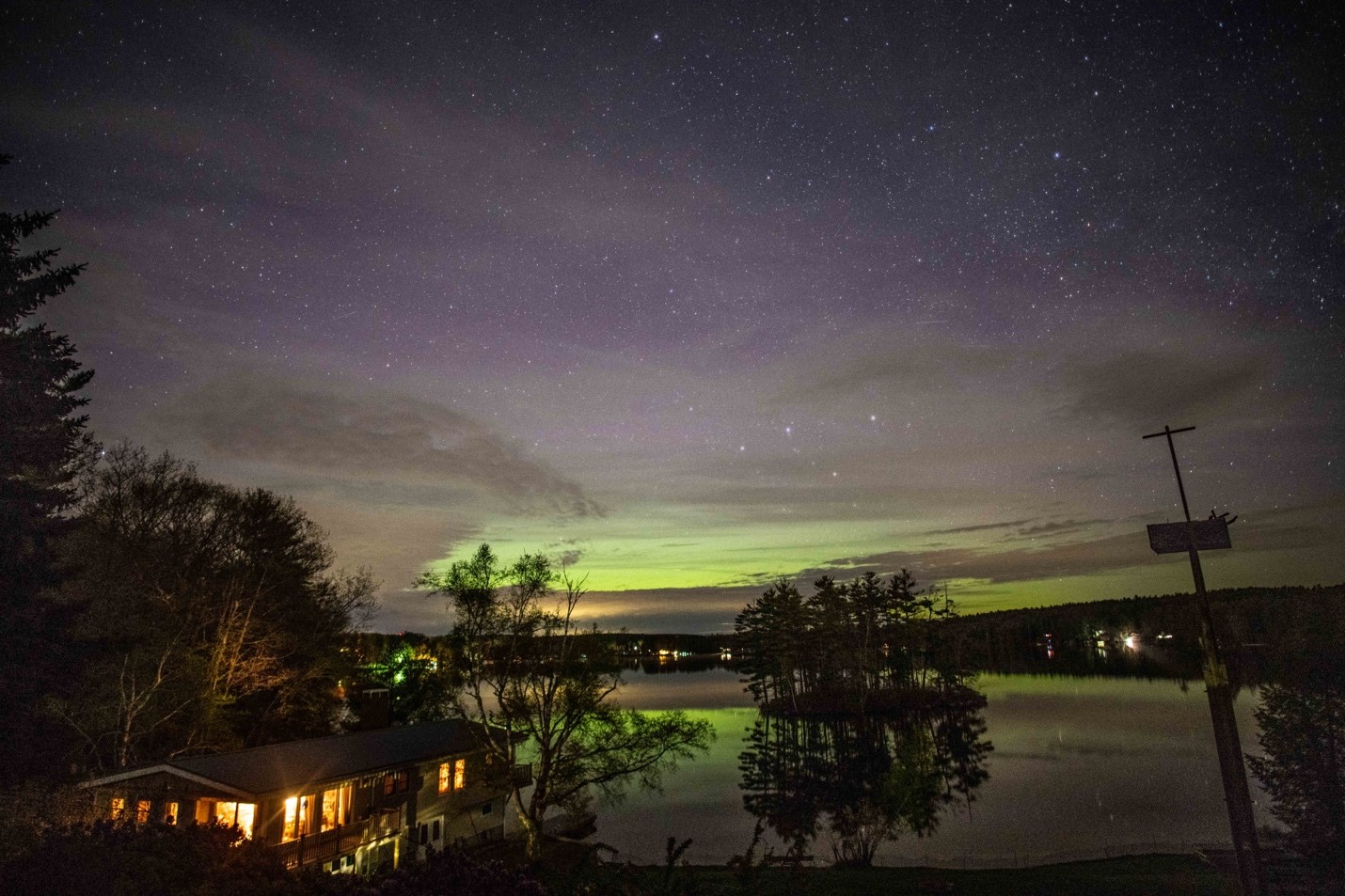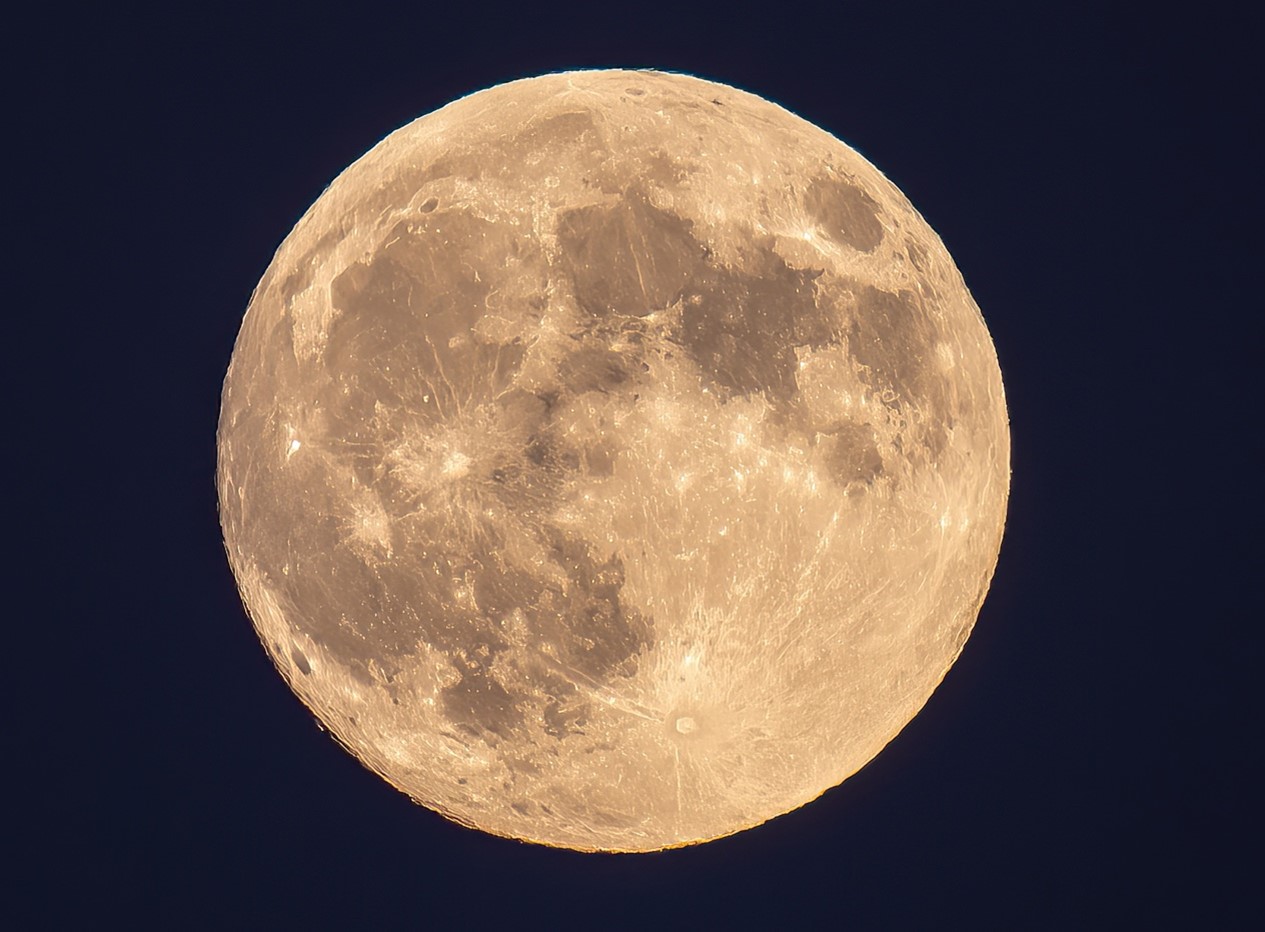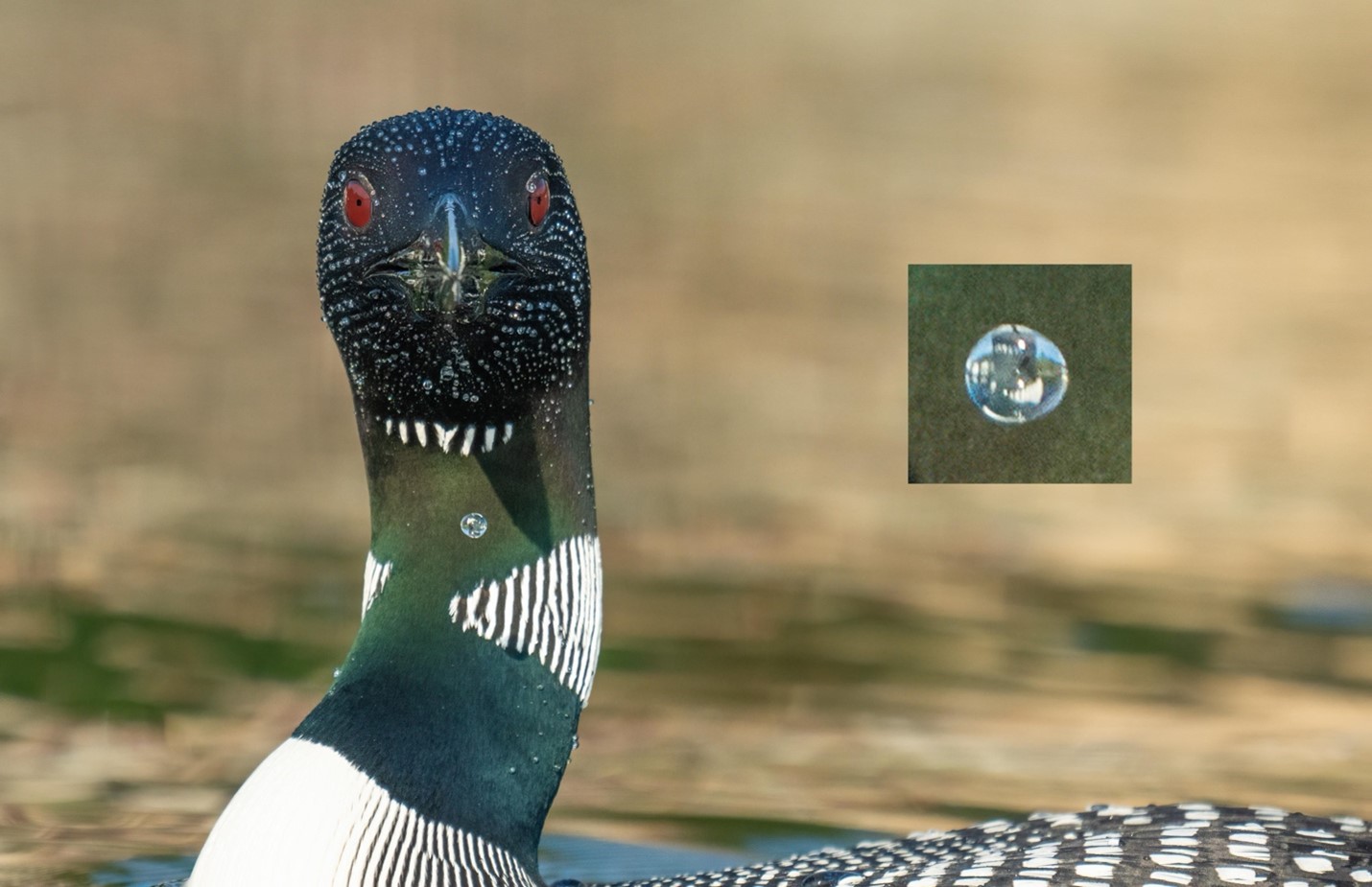Photos of Things Great and Small
Caution: If you have dropped LSD today,
I suggest you wait until you stop tripping before you read this.
In 2024 we were blessed with four memorable astronomical events – the total eclipse, the aurora borealis, the comet Tsuchinshan-ATLAS and a Supermoon. To conclude my presentation, I am going to return from outer space to our little corner of the earth for another event, a very small one, but no less wonderous than the others.
I am no one to give science lessons, but I have written enough text, so you know what you are looking at. If you want to learn more, as my father used to say, “Go look it up”.
The Total Solar Eclipse April 8 at 3:21 p.m.

The total eclipse could only be viewed along the dramatically named “Path of Totality” – a strip of land between 50 and 124 miles wide that traversed the US from Texas to Maine. We chose to drive to Millinocket, Maine to witness the spectacle.
Two great miracles to be aware of…
Miracle #1 – The moon has a diameter of 2,159.2 miles or the distance from Sanbornville to Tucson, Arizona. It orbits the earth at about 239,000 miles from your front door. The sun has a diameter of 846,000 miles and is 93 million miles away. The total eclipse happens because the sun is located 400 times farther away from Earth than the moon. And because the diameter of the sun is 400 times larger than the diameter of the moon. You’ve got to let this sink in: the sun is 400 times bigger and 400 times farther away. As a result, the sun and moon appear to be the same size. This allows the moon’s shadow to block out the sun’s disk and reveal the sun’s corona. The size of the moon relative to the sun and the distance ratios of the moon and sun are unique to Earth. We are the only planet in the solar system that experiences total eclipses. Is this a coincidence or God having fun?
Miracle #2 – The technology that enables us to see “Miracle #1” was invented by “Miracle #2”
a device that is the pinnacle evolutionary achievement of our solar system since its inception 4.5 billion years ago – the frequently under used device that sits between our ears and waits patiently for us to call it into action – the human brain.
Prominences…You can see what looks like flames shooting from the lower left and right of the sun. Ryan French, an astrophysicist at the National Solar Observatory says: “The bright features are not “solar flares”, but “prominences”, which are longer-lived plasma structures and not explosive flares.” I did some calculating and had my numbers checked by smart people. The prominence in the lower left extends about 48,000 miles from the surface of the sun. The diameter of the earth is 7,926 miles, which means you can fit six Earths side-by-side within the prominence.
The Next Time…
Total solar eclipses are visible every few years, but from any one location the frequency is roughly 375 years. The next one visible in Millinocket will be in 2399. Travel Tip: The traffic in Millinocket was not nearly as bad as places like Burlington, VT. The restaurants aren’t as good, but you can get by.
The Aurora Borealis May 11 at 11:59 p.m.


The Aurora Borealis, commonly known as the Northern Lights (and the Aurora Australis, Southern Lights) are caused by the interaction between solar wind (streams of charged particles ejected from the sun) and Earth’s magnetic field. When these particles collide with the gases in the Earth’s atmosphere, they create the vibrant colors of the auroras, ranging from green and pink to red and purple. The auroras are most visible in the most northern and southern latitudes, and we were lucky to have a showing this year.
These photos aren’t great, but they are the best I could do. There were northern lights in the fall as well, but viewing from the lake was weak.
Comet Tsuchinshan-ATLAS October 12 at 5:52 p.m.

This one strains credulity. Plus, if you missed it, don’t hold your breath waiting for the return. The next time Tsuchinshan-ATLAS returns our neighborhood will be in 80,664 years. Scientists guess that the comet was born in the Oort Cloud (But, full disclosure, the Oort Cloud has only been theoretically predicted. No one knows if it exists, but the comet had to come from someplace, I suppose, and I don’t have any better ideas.) The Tsuchinshan-ATLAS may have formed early on in our solar system’s history when icy objects were flung outward away from the Sun due to the gravitational action of the planets.
The comet nucleus consists of ice and dirt – kind of a dirty snowball. The guess is that the diameter is about 10 miles, so about the distance from Sanbornville to Acton. Now, get this, the closest it came to earth was 44 million miles and you could see it with your naked eye. To further bewilder, the thing is moving 180,000 miles per hour. When the comet got close to the sun, if you can call 59 million miles close, it warms up and the ice turns into gas and these gases mix with the dirt of the comet and create the coma (the fuzzy glow around the center) and the tail which can extend for millions of miles.
I gotta tell you, I’m not sure I believe any of this. How can something 10 miles across travel for 4.6 billion years and produce a tail millions of miles long without running out of dirt and ice? And how can something that small be seen 44 million miles away? And do you mean to tell me that the comet traveling us at 180,000 mph for 40,000 years (that’s 579 trillion miles), then makes a “U” turn, and travels another 40,000 years back to us, and they know for certain the date? To add to the incredulity, it was created in a place called Oort which may not exist? Listen, the fact is that the thing was first seen and named in China, which is the reason for the unpronounceable name. I’m betting it’s a spy satellite.
The Supermoon October 16 at 6:29 p.m.

Supermoon is a term that describes the moon when it is closer to Earth than normal. On average, the moon is about 239,000 miles from earth, but our Supermoon was 222,000 miles away, so 17,000 miles closer, the closest moon to earth this year. Because of this it looks 8% bigger and 16% brighter than a regular full moon. Now, this one makes sense.
The Loon and The Drop August 25 at 7:29 a.m.

I titled this article Things Great and Small. We are leaving the world of great for the world of small, but I think the small is just as great. I took this photo from about 30 yards away. The loon popped up from a dive and stared at me. The total time my shutter was open for this photo was 1/2500 of a second. It takes 1/10 of a second to blink, so I could take 250 of these in the time it takes you to blink once.
When I opened the photo in the computer, I loved the expression – whatever it means. Then I noticed the drop suspended a couple of inches below the bill. It measures about 1/10 of an inch in diameter. That’s like the combined thickness of two pennies. Inside the drop, you can see the reflection of the loon’s neck and back. As you may know, a reflected image in a drop is inverted. To make the reflection easier to see, I enlarged the drop and turned it upside down. Old people may need a magnifying glass for this one.
So, in just a few minutes of your time, we have covered a lot. Distances from 1/10 of an inch to 579 trillion miles and the passing of time from 1/2500 of a second to 80,660 years. Consider that those two photos – the comet and the drop – were taken from locations on the lake about 200 yards apart. I will leave it to you to contemplate your own conclusion to these wonders. My mind is blown.
“There are only two ways to live your life. One is as though nothing is a miracle. The other is as though everything is”. Albert Einstein.

